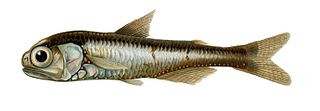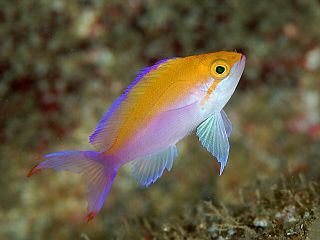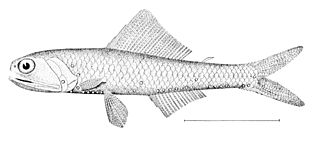
Lanternfishes are small mesopelagic fish of the large family Myctophidae. One of two families in the order Myctophiformes, the Myctophidae are represented by 246 species in 33 genera, and are found in oceans worldwide. Lanternfishes are aptly named after their conspicuous use of bioluminescence. Their sister family, the Neoscopelidae, are much fewer in number but superficially very similar; at least one neoscopelid shares the common name 'lanternfish': the large-scaled lantern fish, Neoscopelus macrolepidotus.

Ridgeheads, also known as bigscales, are a family of small, deep-sea stephanoberyciform fish. The family contains approximately 37 species in five genera; their distribution is worldwide, but ridgeheads are absent from the Arctic Ocean and Mediterranean Sea. Although the family is one of the most widespread and plentiful of deep-sea families, none of its members are of interest to commercial fishery.

A viperfish is any species of marine fish in the genus Chauliodus. Viperfish are characterized by long, needle-like teeth and hinged lower jaws. A typical viperfish grows to lengths of 30 to 60 cm. Viperfish stay near lower depths in the daytime and shallower depths at night, primarily in tropical and temperate waters. Viperfish are believed to attack prey after luring them within range with light-producing organs called photophores, which are located along the ventral sides of its body, and with a discrete photophore at the end of a long spine in the dorsal fin reminiscent of the illicium of the unrelated deep-sea anglerfishes. The viperfish flashes this natural light on and off, at the same time moving its dorsal spine around like a fishing rod and hanging completely still in the water.

The blue maomao, also known as the violet sweep, blue sweep or hardbelly, is a species of marine ray-finned fish, a member of the subfamily Scorpidinae, part of the sea chub family Kyphosidae. It is native to the southwestern Pacific Ocean from Australia to New Zealand and the Kermadec Islands, where it can be found in inshore waters from the surface to depths of 30 m (98 ft). This fish can reach a length of 40 cm (16 in). It is commercially important and is also a popular game fish.

The smalleye pygmy shark is a little-known species of squaliform shark in the family Dalatiidae, found in water 150–2,000 m (490–6,560 ft) deep near Japan, the Philippines, and Australia. It migrates vertically daily, spending the day in deep water and the night in shallower water. One of the smallest shark species, the smalleye pygmy shark is known to reach only 22 cm (8.7 in) long. It has a blackish, spindle-shaped body with relatively small eyes, and a spine preceding the first dorsal fin, but not the second. Bioluminescent photophores occur on its underside, which may serve to disguise its silhouette from predators. This species feeds on small squid, krill, shrimp, and bony fishes. It is aplacental viviparous. The International Union for Conservation of Nature has assessed it as Least Concern, citing its wide distribution and lack of threat from fisheries.

The blue trevally, also known as the banded trevally, barred trevally, Ferdau's trevally or Forskaal's jackfish, is a common, widespread species of pelagic marine fish classified in the jack family, Carangidae. The blue trevally is distributed throughout the tropical and subtropical waters of the Indo-Pacific and central Pacific regions, ranging from South Africa in the west to Hawaii in the east. It is a moderately large fish, growing to a recorded maximum length of 70 cm, with the number of rays in the second dorsal fin and the colouring serving as diagnostic features of the species. The species inhabits waters to depths of 60 m, generally inhabiting reefs, beaches, lagoons, and areas with sandy substrates. It is a predatory fish, taking other fish, prawns, crabs, and molluscs, and very little is known of the species' reproductive biology. The blue trevally is of varying importance to fisheries throughout its range, with some regions having high catches of the fish. It is considered to be a gamefish, and is sought after for its excellent eating qualities.

Pseudanthias bicolor, the bicolor anthias or yellowback basslet is a species of marine ray-finned fish from the subfamily Anthiinae of the family Serranidae, the groupers and sea basses. It is from the Indo-Pacific Ocean. It occasionally makes its way into the aquarium trade. It grows to a size of 13 cm in length.

The blackbelly triggerfish is a ray-finned fish in the family Balistidae found in the Indo-Pacific. It occasionally makes its way into the aquarium trade. It is sometimes known as the blackpatch triggerfish.

The snake mackerel is a species of fish in the monotypic genus Gempylus, belonging to the family Gempylidae. It is found worldwide in tropical and subtropical oceans between the latitudes of 42°N and 40°S; adults are known to stray into temperate waters. It is found to a depth of 600 meters. Populations of the snake mackerel from the Atlantic and the Indo-Pacific differ in vertebral count and number of first dorsal fin spines, and so may represent separate species.
Vinciguerria poweriae is a species of lightfish belonging to the genus Vinciguerria. They are mostly found in seawater 300–600 metres (1,000–2,000 ft) deep during the day and 50–350 metres (160–1,150 ft) deep at night. They feed on small crustaceans.

Vinciguerria attenuata, commonly known as the slender lightfish, is a small species of ray-finned fish in the family Phosichthyidae, found in deep water in warmer parts of the Atlantic, the Indian and Pacific Oceans.

Parapercis hexophtalma, the speckled sandperch, is a species of marine bony fish in the family Pinguipedidae, found in the western Indo-Pacific Ocean. It was first described by the French naturalist Georges Cuvier in 1829. There are several synonyms, some of which represent misspellings of the original name, and others which were given to female fish, at the time thought to be a separate species.

Pelates quadrilineatus, also known as the trumpeter perch or fourlined terapon, is a species of ray-finned fish in the family Terapontidae, the grunters. It occurs in the western Indo-Pacific region, and also in the eastern Mediterranean Sea, having arrived there by passing through the Suez Canal.

Argyropelecus affinis is a species of ray-finned fish in the family Sternoptychidae, found in the tropical and subtropical Atlantic, Indian and Pacific Oceans. Common names for this fish include Pacific hatchetfish, deepsea hatchetfish and slender hatchetfish. It inhabits the mesopelagic zone and is either non-migratory or performs short daily vertical migrations.

Argyropelecus sladeni, or Sladen's hatchetfish, is a species of ray-finned fish in the family Sternoptychidae, found in the tropical and subtropical Atlantic, Indian and Pacific Oceans. This small fish lives in the mesopelagic zone by day and makes a daily vertical migration to the epipelagic zone at night.

Sternoptyx diaphana, the diaphanous hatchetfish, is a species of deep sea ray-finned fish in the family Sternoptychidae. It is the type species of the genus Sternoptyx, and was first described by the French naturalist Johann Hermann in Der Naturforscher 1781.
Astronesthes richardsoni, or Richardson's snaggletooth, is a species of small, deep sea fish in the family Stomiidae. It occurs in the tropical western Atlantic Ocean, the Caribbean Sea and the Gulf of Mexico. First described by the Cuban zoologist Felipe Poey in 1852, it was named Chauliodus richardsoni in honour of the Scottish explorer and naturalist John Richardson. It was later transferred to the genus Astronesthes.

Notoscopelus caudispinosus is a species of lanternfish in the family Myctophidae. It is found in the eastern and western Atlantic Ocean, the Indian Ocean and parts of the Pacific Ocean. It spends the day below 1,000 m (3,300 ft), rising towards the surface to feed at night.

Neoscopelus macrolepidotus, also known as a large-scaled lantern fish, is a species of small mesopelagic or bathypelagic fish of the family Neoscopelidae, which contains six species total along three genera. The family Neoscopelidae is one of the two families of the order Myctophiformes. Neoscopelidae can be classified by the presence of an adipose fin. The presence of photophores, or light-producing organs, further classify the species into the genus Neoscopelus. N. macrolepidotus tends to be mesopelagic until the individuals become large adults, which is when they settle down to the bathypelagic zone.
Trachurus delagoa, the African scad, is a species of jack mackerel from the family Carangidae which is found in the south western Indian Ocean.
















